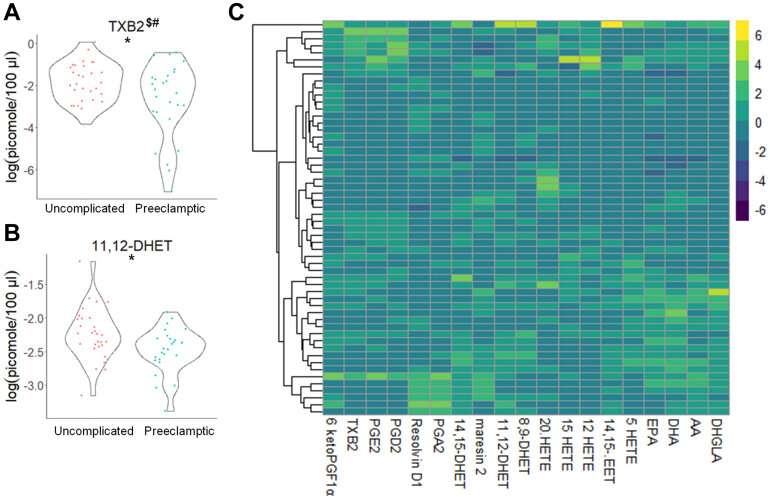
Distinct eicosanoids show significant differences in the plasma from uncomplicated term pregnant patients versus total PE pregnancies. A and B: Eicosanoid species that occurred at significantly different levels when comparing plasma from patients with normal, uncomplicated pregnancies versus patients later diagnosed with PE using UPLC ESI-MS/MS as the detection method. Samples were analyzed by UPLC ESI-MS/MS within two weeks of acquisition. C: Heat map of all eicosanoid species that were detected via UPLC ESI-MS/MS in plasma (depicted as fold change). Samples were compared using unpaired students t test with Welch’s correction. Data are means ± SD depicted as violin plots, ∗P Journal of Lipid Research (2023). DOI: 10.1016/j.jlr.2023.100377
University of Virginia School of Medicine researchers have discovered a way to identify pregnant women at risk of preeclampsia, a serious disorder characterized by high blood pressure and kidney dysfunction which can result in premature delivery, seizures and even death. Complications from the condition are the second-leading cause of maternal death around the world.
The UVA scientists, led by Charles E. Chalfant, Ph.D., found that they could predict the risk of preeclampsia by examining lipids (fats) in women’s blood during pregnancy. The researchers say their finding opens the door to simple blood tests to screen patients.
Further, the approach worked regardless of whether the women were on aspirin therapy, which is commonly prescribed to women thought to be at risk.
“Clinicians have been seeking simple tests to predict risk of preeclampsia before symptoms appear. Although alterations in some blood lipid levels have been known to occur in preeclampsia, they have not been endorsed as useful biomarkers. Our study presents the first comprehensive analysis of lipid species, yielding a distinctive profile associated with the development of preeclampsia,” said Chalfant, of the School of Medicine’s Division of Hematology and Oncology and the Department of Cell Biology.
“The lipid ‘signature’ we described could significantly improve the ability to identify patients needing preventative treatment, like aspirin, or more careful monitoring for early signs of disease so that treatment could be initiated in a timely fashion.”
Understanding preeclampsia
Preeclampsia affects up to 7% of all pregnancies. Symptoms typically appear after 20 weeks and include high blood pressure, kidney problems and abnormalities in blood clotting. The condition is associated with dangerous complications such as kidney and liver dysfunction and seizures, as well as a lifelong increased risk of heart disease for the mothers. An estimated 70,000 women around the world die from preeclampsia and its complications each year.
Doctors commonly recommend low-dose aspirin for at-risk women, but it works for only about half of patients, and it needs to be started within the first 16 weeks of pregnancy—well before symptoms appear. That makes it all the more important to identify women at risk early on, and to better understand preeclampsia in general.
Chalfant and his team wanted to find “biomarkers”—biological indicators—in the blood of pregnant women that could reveal their risk of developing preeclampsia. They examined blood plasma samples collected from 57 women in their first 24 weeks of pregnancy, then looked at whether the women went on to develop preeclampsia. The researchers found significant differences in “bioactive lipids” in the blood of women who developed preeclampsia and those who did not.
This, the researchers say, should allow doctors to stratify women’s risk of developing preeclampsia by measuring lipid changes in their blood. The changes represent an important “lipid fingerprint,” the scientists say, that could be a useful tool for identifying, preventing and better treating preeclampsia.
“The application of our comprehensive lipid profiling method to routine obstetrical care could significantly reduce maternal and neonatal morbidity and mortality,” Chalfant said. “It represents an example of how personalized medicine could address a significant public health challenge.”
The findings are published in the Journal of Lipid Research.
More information:
Daniel J. Stephenson et al, Bioactive lipid mediators in plasma are predictors of preeclampsia irrespective of aspirin therapy, Journal of Lipid Research (2023). DOI: 10.1016/j.jlr.2023.100377
Citation:
Lipid test can reveal risk of preeclampsia, a potentially deadly pregnancy complication (2023, July 14)
retrieved 16 July 2023
from https://medicalxpress.com/news/2023-07-lipid-reveal-preeclampsia-potentially-deadly.html
This document is subject to copyright. Apart from any fair dealing for the purpose of private study or research, no
part may be reproduced without the written permission. The content is provided for information purposes only.
>>> Read full article>>>
Copyright for syndicated content belongs to the linked Source : Medical Xpress – https://medicalxpress.com/news/2023-07-lipid-reveal-preeclampsia-potentially-deadly.html
